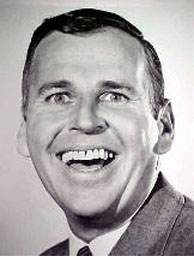The Madness of King George
The following article -- found here -- was published in the September 2002 issue of Los Angeles magazine.
After 13 seasons as the great and powerful Oz behind The Simpsons, writer-producer George Meyer is finally taking his leave from the show he helped shape into a global phenomenon. At a boyish 45, he's too young to retire. One might expect to see him try his hand at another TV show or the movies, but one would be wrong: "I've accomplished my goals in the mass media," Meyer says. "These days I find homemade spectacle more rewarding."
Accordingly, in late June, about a hundred people packed into the tiny Court Theater in West Hollywood to witness the homemade spectacle of Up Your Giggy, a play Meyer wrote, directed, and starred in that his longtime girlfriend, Maria Semple, produced. Despite boasting a cast that constituted a comedy Dream Team--including fellow Simpsons writer and stand-up Dana Gould, Mystery Science Theater 3000 creator Joel Hodgson, and Mr. Show alum Mary Lynn Rajskub--the production had something of a community-theater vibe. None of the actors was paid. Tickets cost just $10. Publicity was limited to word of mouth and a Web site (www.upyourgiggy.com). The theater was booked for only seven performances over two consecutive weekends. And it was Meyer's first time performing.
Ten days before the show opened, with the cast yet to rehearse, Semple, a former writer on such shows as Mad About you and Ellen, was by turns enthusiastic and blase. "We've been together for 12 years, but George doesn't want to get married--he doesn't believe in marriage--so I figure this is as close as I'll ever get to a wedding reception," she said in one breath, and in the next said, "If it's not fun, we'll close it down after the first show." The original run of seven shows quickly sold out, and two others were added to accommodate a waiting list that stretched into the hundreds.
Up Your Giggy hopscotched between sublimely absurd skits featuring the more experienced actors, such as the one depicting a movie starring deceased Wendy's spokesperson Clara Peller, played by Gould; all her dialogue had been posthumously cobbled out of her line "Where's the beef?" Between sketches Meyer delivered monologues that served as more straightforward target practice on his favorite betes noires: advertising ("If lies were garlic bread, advertising would be the Olive Garden"), family, and other pinatas like feminism, religion, and marriage (referred to variously as "a garish carnival of conformity" and "a stagnant cauldron of fermented resentments, ... dull weekends in Santa Barbara, and the secret dredging up of erotic images from past lovers in a desperate and heartbreaking attempt to make spousal sex even possible"). It wasn't exactly a feel-good show, yet Meyer presented his oft-acidic views in a package so amusingly constructed, even those who might have been appalled by the sentiments expressed couldn't help but laugh, hard.
"In my more romantic moments, I wanted half the audience to walk out," Meyer says, betraying a certain Bart-like contrariness, "but I imagine actually experiencing that would be excruciating." He never had to.
A celebrity attendee did give Meyer some pause, however. In one monologue he voices, among other things, his hope that Patricia Arquette won't ever "get adult braces, because the slight crookedness of [her] smile is unbearably sexy." Hearing this, Flirting with Disaster director David O. Russell returned for a second performance, bringing the actress with him. "So George is out there doing the monologue when he spots her in the front row! His jaw dropped--he got really flustered, and it took him a little while to recover," Semple recounts with a slightly wicked laugh.
After the opening-night performance, cast, crew, and audience (which, over the course of the run, included Eric Idle, Matt Groening, Kevin Nealon, and Hank Azaria) mingled under the soft light of a crystal chandelier perched in the crook of a tree in the Court's courtyard, nibbling heart-shaped cookies and drinking mojitos, which Semple had made using mint from her garden. The couple's button-eyed mutt, Chester, threaded his way through the guests' legs, presumably looking for his master. It was easier for a person to spot Chester's lanky owner, the exhilarated un-groom, across the courtyard, greeting well-wishers and crowding together every so often with one or more of them for photos.
A few days after the show closed, on the eve of a celebratory trip to a Santa Barbara spa, the couple seemed energized by the success of their first theatrical effort. Now Meyer and Semple are looking into producing another run of Up Your Giggy. Says Meyer, "We got such a good response to the show that it seems almost a shame not to do something else with it. In retrospect we didn't charge enough--I would love to do it again but not get completely hosed on it."


